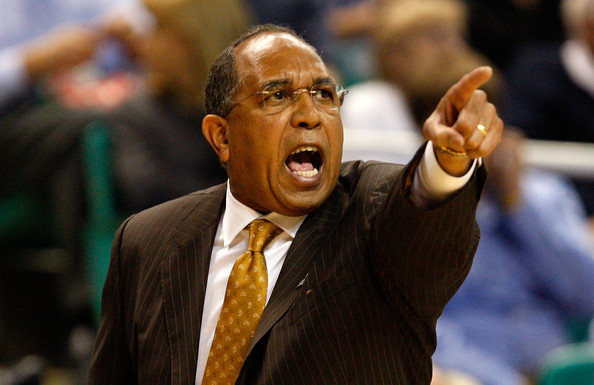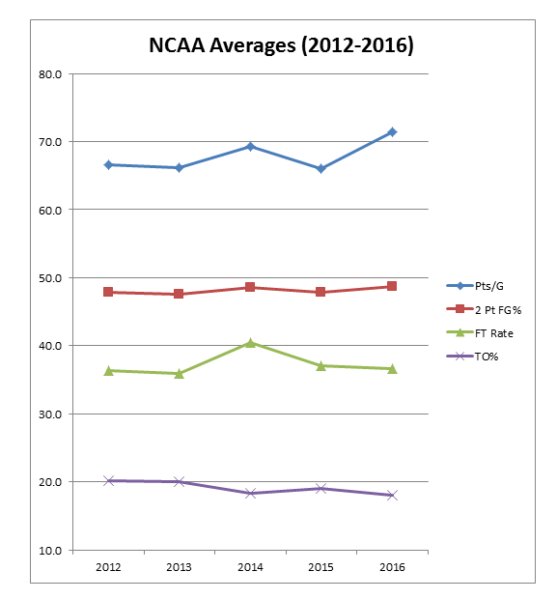Posted by Brian Otskey on February 27th, 2013

Brian Otskey is an RTC columnist. Every Tuesday during the regular season he’ll be giving his 10 thoughts on the previous week’s action. You can find him on Twitter @botskey
- Much has been made about the decline in scoring in college basketball over the last decade. These days, it is very common to see games played in the 60s, 50s or even 40s in some instances. It is true that scoring has decreased substantially over the last 10 years and the numbers bear it out. In the 2002-03 season, 172 teams averaged at least 70.0 PPG. That number has steadily declined, falling to 145 five seasons ago and 111 this year. With the advent of advanced statistics, one in particular stands out. Ten years ago, 123 teams averaged an adjusted tempo of 70.0 possessions per game. That was cut in half by 2007-08 (62 teams) and the number has continued to decline even since then. This season, only 28 of America’s 347 Division I teams play at that pace or greater. Why is this happening? Pace is certainly a factor but there are other issues at play here. With the proliferation of television coverage and video based scouting programs such as Synergy Sports Technology, scouting and video material is more available than ever. Head coaches and their staffs know everything about an opponent and that makes a huge difference for a lot of teams on the defensive end. A lot of teams run the same sets and it’s simply easier to prepare when you see the same thing over and over again. The elephant in the room, however, is the talent level in college basketball. Most of us probably wouldn’t like to admit it but the talent level has noticeably dipped in our sport over the last decade. I’m not talking about a once in 20 years type of player like Kevin Durant but the overall depth of talent in the game. There’s a reason a lot of people are saying this year’s NBA Draft class could be the weakest ever. That’s because it is. Until college basketball gets a much-needed infusion of talent, low scoring games will remain the norm.
- A lot of people would like to see the so-called “one-and-done” rule fade to black and that got me thinking about some much-needed rule changes in college basketball. I’m not going to discuss the one-and-done here, I’m talking about changes that need to be made during the actual games. If I had the power, the first thing I’d do is shorten the shot clock to 30 seconds. Five seconds may not sound like a lot but since there are roughly 66 to 67 possessions in an average Division I game, that would translate into another 10 possessions per game. Immediately you’d see an increase in scoring which makes the game more attractive to fans. One thing that annoys me is the amount of timeouts and stoppages in the game. There are already four mandated media timeouts every half and each team gets a total of five timeouts per game. In an era when coaches rarely leave timeouts on the table, there are 18 different timeouts in a typical college game, an average of one every two minutes and 13 seconds. It hurts the flow of a game in a big way and my proposal would be to reduce the number of timeouts to three per team and no extras in overtime. The end of every college basketball game these days seems to include a multitude of timeouts, fouls and official reviews. Officials reviewing plays has helped many sports get calls right, including college basketball. However, officials are abusing the monitor more than ever before. A big reason why is the NCAA rule change a few years ago regarding flagrant fouls and elbows thrown. I get why this rule was implemented (player safety) but there is no evidence this rule acts as a deterrent. Players have been taught from a young age to clear space with your elbows when being pressured by a defender. Now, a loose elbow can be deemed a flagrant foul even if there was no intent to injure by the offending player. This has to change. I have absolutely no problem with calling a flagrant foul for a malicious elbow or other physical contact. But calling a flagrant for an innocent or accidental elbow is wrong and is another thing that contributes to college games that lack an entertaining flow. A couple other changes I’d make include not resetting the 10-second count in the backcourt after a timeout, not being able to inbound the ball into the backcourt (it’s a bailout move for a team without a quality inbounds play) and starting the 1-and-1 bonus at nine fouls instead of seven. What are your thoughts on some of these proposals?

Tubby Smith has Minnesota pointed in the right direction
- This time of year, bubble talk dominates the discussion. My way of looking at bubble teams is simple: Did you beat quality opponents and what have you done away from home? This approach is one Jay Bilas mentions on television every year, something I wholeheartedly agree with. I remember years ago when Bilas went on ESPN and said something like, “Bubble teams have all proven they can lose. The question is, who did you beat and where did you beat them?” Truer words have never been spoken. You can’t dismiss all losses but when we’re talking about bubble teams, we’re usually looking at teams that have lost anywhere from 9 to 12 games, sometimes more. When I look at this year’s group of bubble teams, a few stand out. Minnesota is only 7-8 in Big Ten play but has multiple quality wins over Memphis (neutral), Illinois (away), Wisconsin (home), Michigan State (home) and last night’s massive upset of Indiana at the Barn on its resume. All of that trumps Minnesota’s loss to Northwestern and should get the Golden Gophers into the Big Dance. Staying in the Big Ten, Illinois is in the same boat and I believe the Illini have done enough to warrant a bid at this point. Villanova is an interesting team. The Wildcats have a high number of losses (11) but wins at Connecticut and home versus Louisville and Syracuse have them in the NCAA discussion. I think Villanova is an NCAA-worthy team but the Wildcats need to do more to earn a bid because a pair of bad losses on their resume hurt the cause. Teams like St. Mary’s are harder to quantify. The Gaels have just one top 50 win (home vs. Creighton) on their resume and a pair of bad losses to Pacific and Georgia Tech. When a team wins a number of games against poor competition as St. Mary’s has, it’s very hard to determine if they’re NCAA-worthy. I think the Gaels are, but their resume leaves a lot to be desired. Beating Gonzaga in the WCC Tournament would prove to everyone that they deserve a spot. Read the rest of this entry »
| Regular Features, ten tuesday scribbles
| Tagged: adreian payne, Alex Kirk, brandon triche, bubble teams, cameron bairstow, christian watford, cj fair, cuonzo martin, derrick nix, feature, georgetown, illinois, indiana, james southerland, Jarnell Stokes, jim boeheim, jordan mcrae, josh pastner, Keith Appling, Kendall Williams, memphis, Michael Carter-Williams, michigan state, minnesota, new mexico, otto porter, rule changes, scoring, steve alford, syracuse, tennessee, tom izzo, trae golden, villanova
Share this story












































